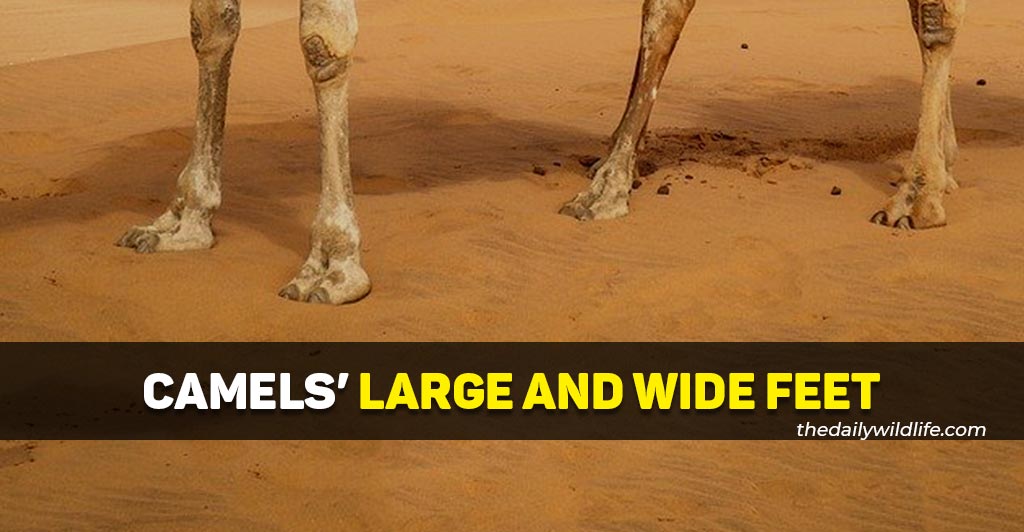Camels have large and wide feet because they support the animals in the sand and enable them to walk there without sinking. Their feet are padded which allows them to cross great distances without burning the bottom of their feet on hot sand. They also reduce musculoskeletal stresses on the body.

Camels are members of the even-toed ungulates (Artiodactyla). What separates them from other members of the species is their pacing gait and unique foot morphology.
Their wide-spread feet enable them to walk on the ever-shifting desert sand and their leathery footpads allow them to walk in rugged rocky terrain. If required, the soles of flexible pads enable them to step onto small stones. [1]
Camels have a secondarily-digitigrade stance where they walk or run by placing their digits on the ground. It is an adaptation from the unguligrade condition where camels developed splay-toed feet and broad foot pads instead of hooves. [2]
Having large and wide feet plays a double role for camels.
Table of Contents
2 Reasons Why Camels Have Large And Wide Feet
1. Less Pressure On The Body Of The Animal
As animals increase in size, the pressure on their limbs increases as well.
In camels, the feet have developed fatty pads or cushions that cover bony parts of the back and front legs. [3]
The role of these fatty foot pads increases as camels become bigger or walk faster. They are in charge of reducing and distributing the mechanical forces of walking.
Stress and pressure are equal to force divided by area – so the stress and pressure of movement can be lowered either by reducing the force that is being applied to an area, or by increasing the surface area to which that force is applied. Simply put: you can reduce the stress by reducing the stress your body makes on the foot pads, or by increasing foot pad size.
This is where the camel’s broad and webbed feet come in handy, they increase that surface area.
For example, in humans, between 50 and 90% of the stress wave coming to the knee from the heel is reduced thanks to foot pads, and almost 98% of the stress going to the head.
Similar to how running shoes work on humans, the thick fat pads in camels reduce the pressures associated with walking/running to other parts of the body.
2. Less Pressure On The Ground
The larger and wider the feet are, the better that pressure will be distributed on the ground. And in camels, the contact area with the ground increases with the body mass of the animal.
In camels, the bigger pressure on the surface is exerted by the front feet. Possibly, this is why their front foot pad is bigger than the back one. (More on the size in the second part of the article.)
Usually, when an animal starts walking faster, the contact with the ground increases, along with the pressure exerted on the ground.
Interestingly, that is not the case with camels.
One study has shown that with the increase in walking speed in camels, a non-significant increase in vertical ground reaction force can be noticed.
One of the reasons for that is the structure of their pads.
Camel’s foot pads are made out of a collagenous layer, filled with a viscous gel-like tissue that is threaded with elastic fibers. This means that, when a camel picks up the pace, these elastic fibers can stretch and increase the contact area with the ground. After the animal is done running, the stretched foot cushion returns to its normal shape.
This increase of the contact area in response to the increase in velocity is a pressure reduction mechanism of a camel’s foot.
A lot of people seem to think that camels need shoes. We have an article examining disadvantages to that; read it HERE.
How Big Are Camel’s Padded Feet?
The camel’s feet are very large. The foot pad of the front leg is 7.5 inches long and 5.5 inches wide (19 by 14 cm). The back foot pad of an adult camel is 6.3 inches long and 5.5 inches wide (16 by 14 cm). These large leathery foot pads prevent the camel from sinking too deeply into the soft sand found in dune areas.
| Camel feet | Length | Width |
| Front feet | 7.5 inches | 5.5 inches |
| Hind feet | 6.3 inches | 5.5 inches |
Compared to other ruminants, a camel’s feet are softer and friendlier to vegetation. They are less likely to damage the soil or contribute to the degradation of the pastures.
However, in Australia, camels are considered pests as they cause degradation to soil there. Read more about it in our article.
Conclusion
And there you have it, “why do camels have large and wide feet” explained.
Camel has large and wide feet to reduce the locomotion pressures on its legs and body, to prevent it from sinking in the sand, to allow it to walk on hot sand without getting injured, and to save energy while doing so. They enable the camel to walk without making noise and without damaging vegetation.
Further reading: Why camels have long and thin legs
References
[1] Badawy, Adel M. “Computed Tomographic anatomy of the fore foot in one-humped camel (Camelus dromedrus).” Global veterinaria 6.4 (2011): 417-423.
[2] Janis, Christine M., Jessica M. Theodor, and Bethany Boisvert. “Locomotor evolution in camels revisited: a quantitative analysis of pedal anatomy and the acquisition of the pacing gait.” Journal of vertebrate paleontology 22.1 (2002): 110-121.
[3] Clemente, Christofer J., et al. “Biomechanical insights into the role of foot pads during locomotion in camelid species.” Scientific reports 10.1 (2020): 1-12.
[4] Dagg, Anne Innis. “The locomotion of the camel (Camelus dromedarius).” Journal of Zoology 174.1 (1974): 67-78.